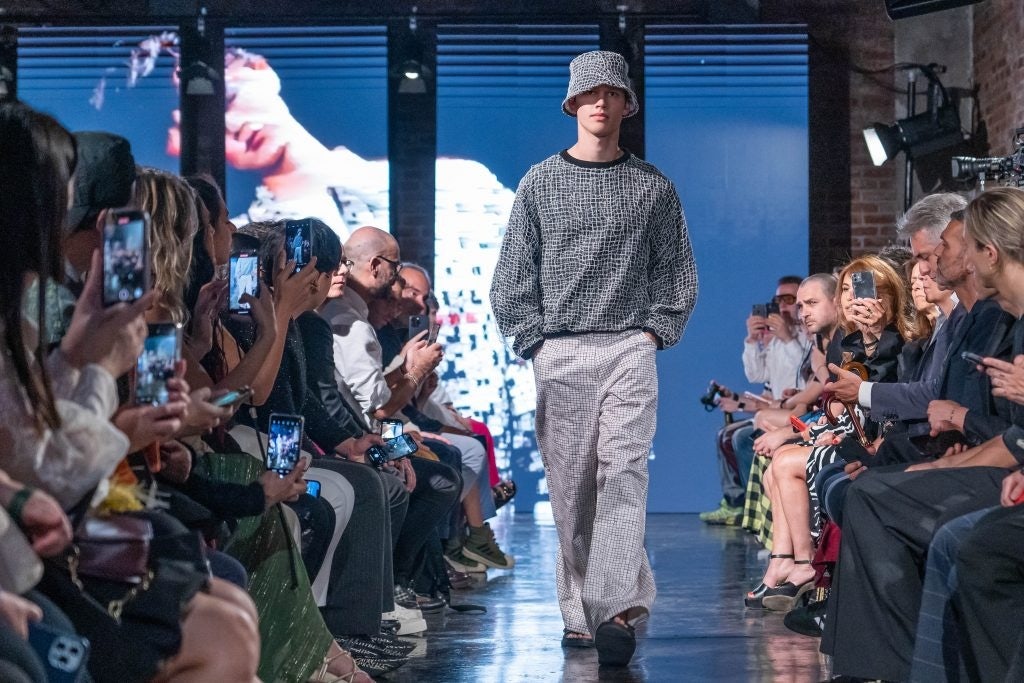The 1990s gave us Alexander McQueen, and the 2010s saw names like Jonathan Anderson and Alessandro Michele rise to public prominence. But what will the next generation of fashion designers look like?
The proliferation of Web3 and artificial intelligence (AI) applications such as Midjourney and Dall-E is accelerating at unprecedented speed, prompting fashion schools across the globe to future-proof their curriculums in efforts to foster the next wave of industry trailblazers.
“We have no choice but to teach these [new technologies] and encourage exploration of them. [But] in a way, it's almost impossible to teach. It's about encouraging students to see what they can do with it,” Roger Tredre, course leader of the Fashion Communication master’s degree program at Central Saint Martins, tells Jing Daily.
Over the past 12 months, leading fashion education institutions like Central Saint Martins have come to acknowledge the wider cultural impact of digital fashion. What started as an underground movement has become a worldwide shift in how contemporary fashion, art, and design are perceived.

Parsons School of Design x Roblox#
In November last year, Parsons announced the launch of its digital fashion education program in partnership with gaming platform Roblox. The 16-week course introduced digital fashion practices and toolkits to fledgling talent who wanted to expand on their skill sets. Students were not required to be already tech-savvy in virtual design, they just had to be eager to learn.
“Roblox has created so many new career pathways for people, especially those who are making a living from creating digital items on the platform. I wanted to be able to give those assets to my students to show how the channel is more than just a place for kids to hang out, it’s a business opportunity,” Kyle Li, Assistant Professor of Intermedia at Parsons, says.

The course immersed students in Roblox’s proprietary Layered Clothing Technology, alongside the inner workings behind modern-day user-generated content. Over the semester, they were tasked with grappling with Roblox's continually upgrading Creator Roadmap features, tackling game modification, and prototyping inclusive 3D apparel.
The end result was a fashion show hosted in Roblox via a virtually-rendered runway. Each student’s final concept eventually went up for sale on Roblox’s Avatar Marketplace.
In 2022 alone, more than 11.5 million creators designed over 62 million items of virtual clothing and accessories on Roblox, according to the platform’s ‘2022 Metaverse Fashion Trends’ report. Some of these creators, like Rush Bogin, are carving multimillion dollar careers out of their virtual fashion designs.
“As more platforms like Roblox start to surface, we realized that there are very few skill sets being taught in universities, so we’re trying to support these prerequisites so that our students can go on to be successful on these platforms,” Li adds.

Istituto Marangoni's virtual 'Talent District'#
Istituto Marangoni has also been busy equipping its scholars with cutting-edge technology. The international school was one of the first to venture into the metaverse when it established its own virtual world and teaching space, 'The Talent District,' in June 2022.
As part of its new digital fashion initiative, the institution’s London location hosted its first phygital runway last month. Participating students were encouraged to explore the intersection of the physical and virtual realms through disruptive garment design.
“In our schools, we have noticed how the students are curious and keen to express themselves in the digital world and explore the edgiest tools to test new technologies,” Stefania Valenti, Managing Director at Istituto Marangoni, says. “As the expectations of the elite modern consumer evolve, the very future of fashion relies on meeting them through innovation and sustainability practices that align with luxury brands’ ideals and objectives.”

Esmod’s Meta-wear course#
Esmod, the Paris-based fashion school whose alumni include Olivier Rousteing and Simon Porte Jacquemus, launched its ‘Meta-wear’ class last year. The undergraduate program was designed to develop the skills of future creatives specializing in the metaverse and NFTs by introducing them to tools such as Clo 3D, Blender, Maya and Daz3d.
These schools are ensuring that new, buzzy courses like virtual design don’t overshadow the importance of old-school techniques. Esmod teaches students about the role that traditional crafts play in understanding the complexities of digital garment formation, and is careful not to neglect formal technical aspects like physical pattern making.
AI as core curriculum#
Higher education programs aside, brands are also funneling resources into educational digital fashion initiatives, some targeting students as young as primary school age. Louise Laing, founder of digital fashion startup Phygital Twin, explains how, for its latest project, the label tapped into the creativity of youngsters by inviting them to create their own phygital garment.
Laing believes that this approach opens up a new accessible world for young creatives, and can level the fashion design playing field.

“It’s fascinating that if you go back 20 to 30 years, [a lot of] fashion designers were all historically artists. Now, you don’t have to be able to draw, you can create using the latest 3D design tech. We hope that our 3D AI design/production platform, that’s production ready and enables everyone to be on-demand designers, will democratize the fashion industry by breaking down all barriers to entry and reducing waste,” Laing says.
Similarly, with AI-generated programs like Midjourney becoming near ubiquitous, alternative doors are opening for creatives who may not have access to these elusive institutions to gain valuable exposure and explore their vision.
Matthew Drinkwater, head of the Fashion Innovation Agency (FIA) at London College of Fashion, believes that AI applications should also be taught as core curriculum subjects.
“Artificial intelligence will be equally important in delivering a more immersive future, so it's inevitable that students will need to engage with those tools,” he says.
The university launched the FIA initiative, a division set up to help scholars stay at the bleeding-edge of technology, in 2013, and has been running courses on AI since 2019.

A hybrid future#
As students follow in the footsteps of their legendary predecessors, many find themselves working under some of the most prominent names in fashion along the way. But with more industry arbiters turning to digital activations as part of their evolution, newcomers will have to be well-versed in the tools of Web3 to keep up with the fast-accelerating landscape.
“The world will become increasingly filled with 3D content, and it's critical that we enable students to understand how emerging technologies will influence their future career – whatever field they are entering,” Drinkwater continues.
Fashion’s next trailblazers are keen to finesse their craft. Adopting an interdisciplinary mindset across the IRL and URL, these creatives are now straddling the boundaries of know-how – from graphic design and coding to 3D development and generative AI – to push the parameters of traditional fashion practices.
Valenti believes this shift adds depth to students’ craft and that it’s preparing a community of futurists for the ongoing digital transformation.
“Our role as leaders in higher education is to offer our students cutting edge technology to shape their talents and skills in a way that enables them to rethink the creative aspects of fashion, design and art in an innovative way,” she says. “This doesn’t mean that they have to choose between physical or digital, but that they have to explore how to create projects in a new creative dimension for the future.”


